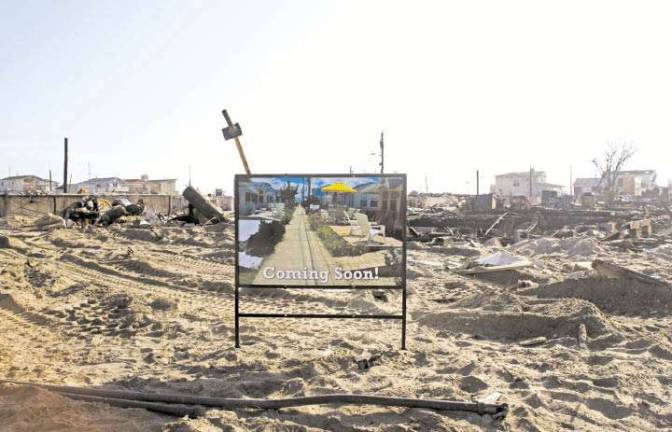Local photos memorialize the historic Hurricane Sandy A dramatic shot by Harvey Stein shows the twisted and mangled Jet Star Roller Coaster in Seaside Hts., N. J., standing several feet in water. In another by Catherine Nance, desperate notices of lost cats are scribbled across a door in Staten Island, while Paul Moakley's image of flooded streets, reflecting a few makeshift lights, resonates with a melancholy beauty. These are just a few of the 200 powerful photographs documenting the devastation and recovery efforts relating to hurricane Sandy in the riveting exhibition, "Rising Waters: Photographs of Sandy," on view at the Museum of the City of New York through March 31. It also includes "Without Power," shots taken by architectural photographer, Alex Fradkin, of the devastated and darkened streets of the Lower East Side.
"Not long after Sandy," says curator Sean Corcoran, "I decided we should do an exhibition of images that would tell the story of the storm and its repercussions. It was such an important historical event." He put out an open call for images, at first planning to present the show six months afterwards. Then he realized that it was a developing story and that more photographs of the rebuilding should be included. In the end, he received 10,000 submissions and, in conjunction with curators from the International Center of Photography, selected 200 color and black and white images for the show, which opened on the anniversary of Sandy in October.
They decided to arrange the images chronologically, dividing them by themes. "The exhibition had to have structure," he says. "We imposed our own guidelines, among them that we would include amateurs and professionals and that the images had to be both aesthetically interesting and advance the story. We hoped to achieve a delicate balance between the look and the content. We have a section simply called `Home,' which is a series of portraits of people working on their houses and facing their loss. Their faces reveal as much about what happened as the images of water engulfing the beaches and streets."
Corcoran not only wanted to document Sandy but also to remind viewers of what happened. "A lot of New Yorkers are still dealing with the effects of the storm," he says. "It's not really over. I'm hoping this will spark conversation about how we might have been more prepared and how we build in the future and provide an infrastructure better equipped for this kind of catastrophe. I also hope people can relate to it on a personal level."
"Rising Waters: Photographs of Sandy" at The Museum of the City of New York, 1220 Fifth Avenue, at 103rd Street, 212-534-1672, [mcny.org].
